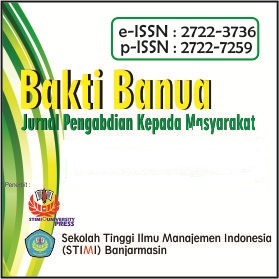EDUKASI PENGELOLAAN LIMBAH BERKELANJUTAN BAGI PENGELOLA MAKAM: STUDI KASUS DI ZIARAH MAKAM GURU ZUHDI BANJARMASIN
DOI:
https://doi.org/10.35130/qnb0gw93Abstrak
Banjarmasin, a city rich in culture and pilgrimage traditions, faces a significant environmental problem with the accumulation of organic waste from pilgrimage flowers, especially in the Guru Zuhdi's Tomb area. Based on observations, the volume of flower waste at the main pilgrimage site can reach 3-5 kg per day and drastically increase to 10-20 kg per day during the haul season. This condition exacerbates the city's organic waste burden, which in 2023 accounted for 55.89% of Banjarmasin's total daily waste generation, equivalent to 170,275.42 tons. Therefore, a community service program was designed to address this issue through comprehensive education. This study aims to educate cemetery managers and the surrounding community on the principles of sustainable waste management. The program adopts a holistic approach that includes socialization, training, and mentoring. The initial phase focuses on raising awareness about the negative impacts of unmanaged flower waste, followed by practical training on waste sorting techniques at the source. Furthermore, participants are given demonstrations on simple methods for processing flower waste, such as composting. The program emphasizes the importance of collaboration and active participation from all parties, involving students from the Economics Education Department at Lambung Mangkurat University and the local community. The expected outcome of this program is the formation of an independent working group capable of effectively managing waste in the cemetery area. With increased knowledge and skills, the cemetery managers are expected to apply best practices in waste management, which in turn will significantly reduce the volume of waste sent to landfills. Moreover, the program also aims to foster broader environmental awareness among the community, changing the paradigm of waste from mere trash to a valuable resource, and demonstrating that simple efforts can have a significant impact on environmental sustainability and community well-being.
Referensi
Admin Protokol Dan Komunikasi Pimpinan Sekretariat Daerah Kota Banjarmasin. (2022). Desa Wisata Religi Kubah Basirih dalam Anugerah Desa Wisata Indonesia 2022. Diakses dari https://prokom.banjarmasinkota.go.id/2022/05/desa-wisata-religi-kubah-basirih-dalam.html
Dinas Komunikasi dan Informatika Provinsi Kalimantan Selatan. (2023). Jumlah Timbulan Sampah Banjarmasin. Diakses dari https://data.kalselprov.go.id/dataset/data/1395
Maylana, D. R. (2024). Analysis of the Remaining Operational Life of the Banjarbakula Regional
Pusat Statistik Kota Banjarmasin. (2024). Jumlah Penduduk (Jiwa), 2018-2020. Diakses dari https://banjarmasinkota.bps.go.id/id/statistics-table/2/OCMy/jumlah-penduduk.html
Rika. (2023). Tradisi Masyarakat Banjar Ziarah Ke Kubah Habib Basirih (Habib Hamid Bin Abbas Bahasyim). Tashdiq: Jurnal Kajian Agama Dan Dakwah, 1(3). https://ejournal.warunayama.org/index.php/tashdiq/article/view/1529
Wikipedia. (2024). Kota Banjarmasin. Diakses dari https://id.wikipedia.org/wiki/Kota_Banjarmasin
Dahliati, R. B., Romadona, A., & Nuryan Arif, Q. (2023). Pelatihan Pengelolaan Daun Kering Menjadi Pupuk Kompos di SMA Muhammadiyah 1 Pekanbaru. [Nama Jurnal Tidak Diketahui].
Handoyo, Sutarno, & Sudarwanto, A. L. S. (2023). Pemanfaatan Sampah Daun Sebagai Energi Alternatif Terbarukan Bentuk Briket yang Menggunakan Perekat Daun Muda Jambu Mete (Annacardium Occidentale L) dan Tepung Kanji (Tapioka) di Desa Parang Kabupaten Magetan. [Nama Jurnal Tidak Diketahui].
Pangestika Tonduko, S. A. W. (2023). Pemanfaatan Sampah Daun Kering yang Diolah Menjadi Pupuk Kompos di SD Negeri Karangsari Yogyakarta. [Nama Jurnal Tidak Diketahui].



